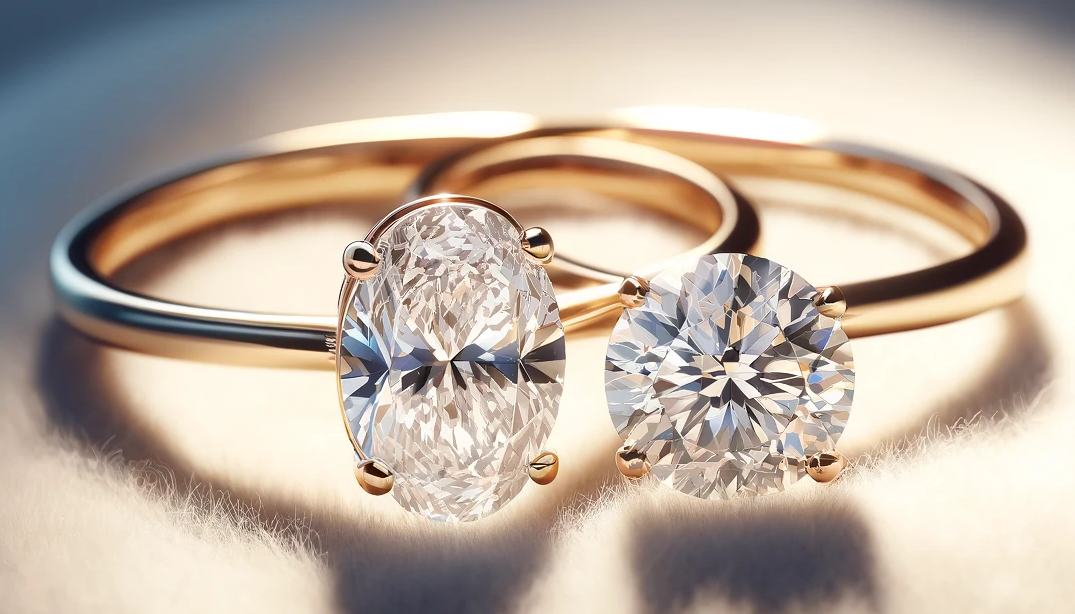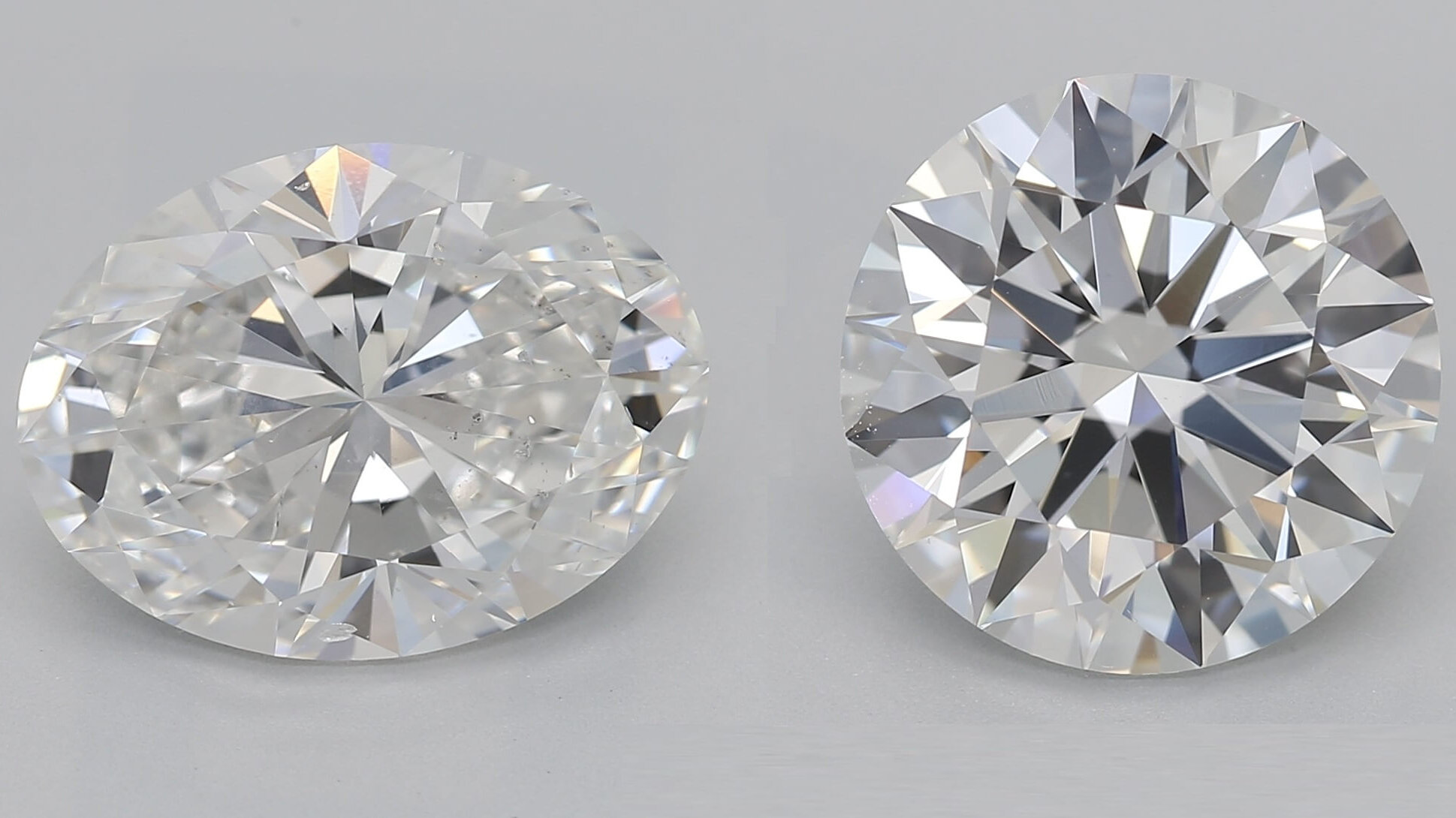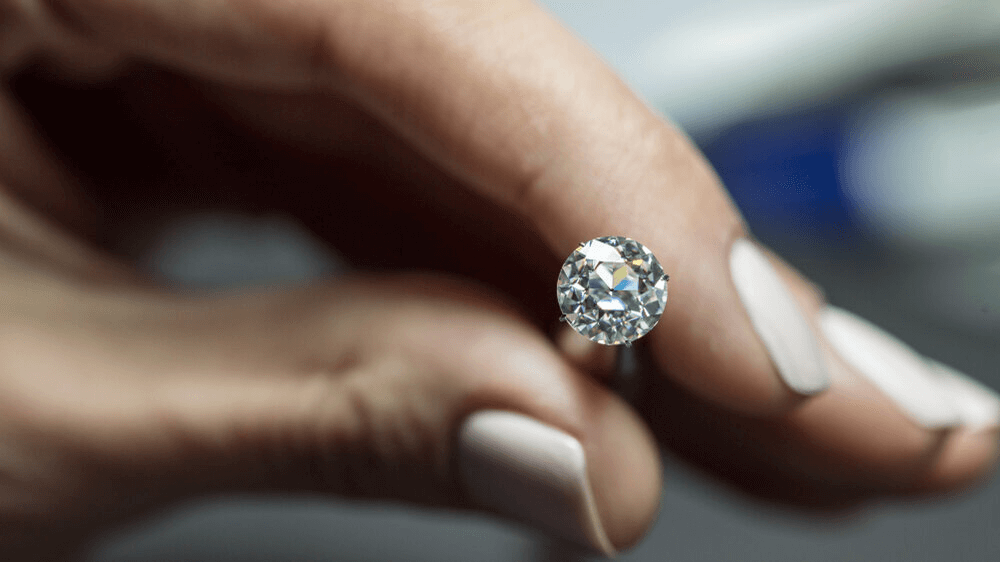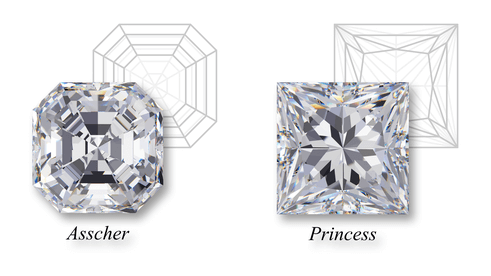Oval vs Round Diamonds: Which One’s Right for You?

By Gary A.

Edited by Olivia H.
Published Jun 28, 2022
Edited on Jan 23, 2025
Choosing between oval and round cut diamonds comes down to whether you prefer the timeless sparkle of a round cut or the unique, elongated elegance of an oval.

- 7 Quick Tips for Choosing Between Oval and Round Diamond Engagement Rings
- Introduction
- Brilliance Unmatched: Round Diamonds
- Size Matters: Perceptions and Realities
- Cost Analysis: Oval vs Round
- Versatility
- The Round Brilliant – Benefits
- The Oval – Benefits
- Our Expert Take
- 10 FAQs
Before we dive deeper into the specifics, here are some practical tips to help guide your decision-making process:
7 Quick Tips for Choosing Between Oval and Round Diamond Engagement Rings
When selecting an engagement ring, especially when weighing the options between oval and round diamonds, certain practical considerations can guide you to make an informed decision. Below are key tips to help you navigate this choice.
- Tip 1: Consider the Visual Impact on the Hand of Oval Diamonds:
They tend to elongate the finger, making them a flattering choice for shorter fingers. Round Diamonds: Offer a classic look that is proportionally balanced and suitable for all hand types. - Tip 2: Analyze the Light Performance and Sparkle Brightness and Fire:
Round diamonds typically exhibit more brilliance and fire due to their symmetrical faceting. Bow-Tie Effect: Be mindful of the bow-tie shadow in oval diamonds; it’s essential to choose a stone where this effect is minimal. - Tip 3: Understand the Size and Carat Perception Face-Up Size:
Oval diamonds often appear larger than round diamonds of the same carat weight due to their elongated shape. Carat for Carat Comparison: When comparing sizes, consider how the diamond’s shape influences its apparent size, not just the carat weight. - Tip 4: Evaluate the Diamond’s Setting Style Setting Suitability:
Both shapes are versatile, but the setting can enhance the diamond’s shape. For instance, halos can make ovals appear larger, while solitaire settings might highlight the round diamond’s brilliance. Orientation: The orientation of an oval diamond (traditional vs. east-west) can offer a unique twist to the ring’s design. - Tip 5: Assess the Cost Implications Budget Considerations:
Oval diamonds can be more budget-friendly due to less wastage in cutting and slightly lower demand compared to round diamonds. Price per Carat: Remember that the round diamond may carry a premium price due to its popularity and cutting process. - Tip 6: Check for Symmetry and Proportions Symmetry in Rounds:
Ensure the round diamond has excellent symmetry for optimal sparkle. Proportions in Ovals: Pay attention to the length-to-width ratio in oval diamonds to find a shape that complements your style and finger. - Tip 7: Think About Long-Term Style and Trends Timeless Appeal:
Round diamonds are classic and timeless, making them a safe choice for those who prefer traditional styles. Current Trends: Oval diamonds are currently trendy, offering a contemporary look while still retaining a timeless appeal.
Now that you’ve got these practical tips, use Jeweler AI below to find the perfect engagement ring that suits your style and budget:
Introduction
Of all the diamond shapes out there, the Oval and the Round are two of the most classic, and the most influential for bridal jewelry. Perfected in the early 1920s, the Round Brilliant is pretty much the MVP of the diamond world. It’s bright, brilliant, and a symbol of the romance of a proposal, recognized across the globe.
The Oval cut is much newer. Created in 1957, the Oval lacks some of the brilliance of the Round cut, but none of the elegance or versatility. It is particularly popular right now, with the simple Oval gold solitaire representing one of the biggest engagement ring trends of the 2020s so far.
But, unless you go for a two or three stone design, you’ve got to find a way to pick just one. Here’s our blow-by-blow comparison of the Oval and the Round Brilliant.

Brilliance Unmatched: Round Diamonds
Unless you’ve been living under a rock for the past few decades, you’ll know that one of the most important features any diamond has is its light performance – that eye-capturing combination of brilliance (white flashes) and fire (multicolored flashes), that makes a diamond stand out from any other gemstone.
One of the first things any shopper learns is that, while the ability to sparkle is an innate characteristic of diamond, it takes a great cut to capture it and bring it out for the eye to see. Each cut manages this differently – and some better than others.
Why Ovals Sparkle Less
A well cut Oval will not sparkle as much as an equally well cut Round Brilliant diamond.
Obviously, if you’re comparing a poorly cut Round Brilliant with an impeccably cut Oval, then the Oval will be much more sparkly and impressive. But, in a like-for-like comparison, the Round Brilliant will be the one to catch your eye – even if you prefer the shape of the Oval.
Why? Because Round Brilliant diamonds are the product of mathematical perfection. The cut was intentionally designed to refract as much light as possible and to offer a stronger light performance than any other shape. The Oval (as well as the Cushion, Marquise, Princess, Radiant, or any other shape you can think of) simply can’t compete with the Round Brilliant.
The Oval shares a lot of similarities with the Round Brilliant, which makes it a very bright, brilliant choice, but it’s an elongated shape. This means that areas of reduced light are almost inevitable – something that can easily lead to the bow tie effect.
The Oval is part of a group of diamond shapes known as the ‘modified brilliants’, while the Round Brilliant is, as the name suggests, the ‘original’ brilliant shape. There’s nothing wrong or ‘second best’ about going for a modified brilliant, but don’t go into it believing they’re all equal in terms of sparkle.
Size Matters: Perceptions and Realities
Sparkle means a lot to a diamond’s beauty, but it isn’t everything. A diamond’s face-up appearance comprises the crown and table – everything you will see when the diamond has been set within your ring, and placed on the wearer’s finger. Different cuts distribute weight differently, meaning some shapes look a lot larger and more impressive than other shapes of the exact same weight.
Oval vs Round Diamonds
Oval diamonds look a little larger than Round diamonds, as a result of their elongated shape and larger surface area.
Not only do Oval cut diamonds feature a larger table, but they are also cut a little shallower (meaning that more weight is distributed across the upper portion of the diamond. The difference isn’t massive, but it is definitely noticeable.
This can be a major selling point for many shoppers – the ability to essentially ‘get more bang for your buck’ in terms of carat weight, and investment. Speaking of which…
Cost Analysis: Oval vs Round
Not all diamond shapes were created equal in terms of sparkle or size, but the same goes for cost. Some shapes are significantly harder to cut, rarer, or more popular (or a combination of all three), making them a lot more valuable.
Why Round Diamonds Cost More Than Ovals
Round Brilliant diamonds have a reputation for being the most expensive shape out there, not just because of their popularity, but because of the difficulties cutters face when creating them.
One of the major downsides to Round Brilliant diamonds is that they generate a lot of wastage during the cutting process. The shapes diamonds naturally form in don’t make it easy for cutters working on Round Brilliants, while other shapes – like the Princess – are perfect for utilizing almost all the original rough.
The Oval isn’t the most economical shape, but it is more economical than the Round Brilliant. Plus, it’s nowhere near as popular. While it is one of the most sought-after shapes, the Round Brilliant accounts for more than half of all diamond sales each year within the US, meaning no other shape – not even the Oval – comes anywhere close in terms of popularity.
As a result, shoppers can enjoy a more attractive price point for their choice. When you’re already on the fence, and one side is 30% cheaper than the other, it’s not hard to figure out where you’re willing to land. If you’re looking at a 1 carat Round Brilliant priced at $6,000 then, theoretically, you’ll save around $1,500 – $1,800 on an Oval.

Versatility
In terms of creating a beautiful ring, rather than just picking out a great diamond, both the Oval and the Round are highly versatile, and the list of designs jewelers can build around them is pretty much endless.
It goes without saying that the Round Brilliant is the most iconic shape ever created. A simplistic Round Brilliant Solitaire is pretty much the face of the bridal jewelry world and one that will likely never be replaced by any other diamond shape or ring design. That said, this shape lends itself to plenty more styles – something modern, like the tension ring or the bezel, or something classic, such as the halo or three stone ring design.
For some people, however, the Round Brilliant represents a slightly ‘safer’ choice – and, for that reason, loses some of its versatility. It’s easier to create something totally new and fresh with one of the less popular shapes than it is to reinvent the wheel.
The Oval is a basic enough shape that it’s equally as versatile as the Round Brilliant, and just as open to new (or classic) designs. Its larger face-up appearance means that it can create more impressive solitaires with lighter-weight diamonds, which is a major plus for shoppers on tighter budgets.
Its elongated shape also means that new and unique designs can be created, even with simple solitaires. An Oval diamond can be placed East-West on the shank, or at an angle – something recently popularized by Ariana Grande following her engagement to now-husband Dalton Gomez.
The Trend Cycle: Are Oval Rings Less Timeless?
In our opinion, no. Oval engagement rings are all the rage right now and have been for a couple of years already, and there’s a good chance they will be replaced by something else at the very height of popularity. But, even so, they’re a classic and versatile enough shape that they’ll never flop out of style – they might just take a backseat.
As of 2022, Oval solitaires have been trending across Instagram, Pinterest, and every other digital mood board for quite some time. It seems like we can’t get enough of Ovals combined with skinny yellow gold bands, or Ovals combined with a hidden halo.
We are, however, in an age of ‘the classics’.
Think of it this way. Big, bulky halos and dramatic Pear diamonds are two trends that are currently experiencing a lull in popular opinion, despite being at the height of popularity just a few years ago. The Round Brilliant, however, is not at the very top of the pecking order right now, but it’s not experiencing a lull.
The story is the same for the Oval cut, and its ability to withstand the test of time. It will be replaced as flavor as the month, but it won’t ever go out of fashion.
The Round Brilliant – Benefits
- It’s the most brilliant shape
If you’re looking to dazzle your partner and harness the full power of diamond’s light performance within your engagement ring, then the Round Brilliant really is the only shape you should be considering. Plenty of other shapes – the Oval included – offer beautiful, scintillating light performances, but the Round Brilliant goes that bit further than any other shape on the market.
Everyone goes into the process of finding a diamond with a different list of priorities but, if sparkle is at the very top of yours, then don’t look anywhere else but at the Round Brilliants available to you. - It’s the classic
Beyond the sparkle, there’s no denying the massive influence the Round Brilliant has had on the world of romance. If you’re a romantic at heart – the kind who cuts paper hearts out of craft paper on Valentine’s Day, and is planning a show-stopping, sunset-capturing proposal – then chances are you can’t imagine getting engaged with anything but the Round Brilliant.
There’s something to love about every engagement ring style and diamond shape, and what we love about the Round Brilliant is its unrivalled impact on brides and grooms across the globe and generations. - It’s great for concealing small inclusions
One of the secrets to buying a great diamond – whatever the shape – is finding one that looks eye clean, but doesn’t carry the sky-high price of a diamond with a clarity grade of FL or IF (or even VVS1 or VVS2).
This is possible for any diamond, but the Round Brilliant is one of the most effective shapes for masking the sort of small inclusions you’ll find in VS and SI clarity diamonds, making it easier to save money on a great-looking diamond.
The Oval – Benefits
- It’s got plenty of sparkle to offer
The Round Brilliant is the leader of the pack when it comes to sparkle, but it’s not like the Oval (or any of the other modified brilliant cuts) can’t offer you anything when the light hits. The Oval still creates a beautiful abundance of fire and brilliance – an incredibly scintillating light performance that lives up to our expectations when we think of diamonds.
Side-by-side, you’ll notice some difference between the Oval and the Round Brilliant but, provided you pick a great cut with excellent proportions, it’s really not that deep – unless you’re pinning absolutely everything on your diamond’s sparkle. - They look bigger
Most of us consider size (or carat weight) to be a major concern when we’re shopping for diamonds. Bigger diamonds get more attention; they look more expensive, more impressive, and more exclusive than smaller – or even ‘average sized’ diamonds. This is particularly true if you’re not planning on adding many accents into your ring. Halos and accent stones can make a diamond look bigger, but the traditional solitaire puts all your cards on the table, so to speak.
Ovals concentrate more of their total weight on the crown and table, rather than the pavilion – a great thing to keep in mind if you’ve got size on your mind. - They’ll never go out of style
It really doesn’t matter if your ring fits with the trends or not, provided you and your partner are in love with it. But, if you’re both pretty conscious of fashion, then it pays to stick to the shapes that don’t get pulled in and out of focus.
The Pear and Heart are two shapes that travel something of a rocky road. One year they’re in, the next year, they’re out. The Oval is totally different – like the LBD of the diamond world.
Our Expert Take
Both shapes are beautiful, bright, brilliant classics of the diamond world. With the Round Brilliant, you’ll get more sparkle, but the Oval offers savings that a lot of shoppers can’t pass up.
This totally depends on the style of ring you’re looking to create, and what your priorities are. Size isn’t everything when it comes to engagement rings but, these days, many people are definitely leaning toward larger center stones for their engagement rings.
If this is the case for you, then you might find that an Oval cut diamond of, say, 1.5 carats appears a little larger than a Round diamond of the exact same weight. Why? Because the shape is elongated – it creates an illusion all on its own, and it’s a little shallower than the Round, meaning that more of the diamond’s total weight is focused on the upper surface of the stone.
The Oval is also a little more affordable than a comparable Round diamond, and versatile enough to suit a wide range of setting styles.
Still, if you’ve found yourself on the fence between the Oval and the Round, then prepare to sit there for some time. The Oval is the second most popular shape among shoppers these days, and weighing up the benefits of both shapes makes it pretty difficult to commit to just one or the other.
There’s no right or wrong choice. If your partner has their heart set on a Round, then the Oval’s potential savings aren’t worth it. If you’re on the fence, however, then exploring what the Oval can offer your ring design is definitely worth your while.
10 FAQs
- Q: Do oval diamonds look bigger than round diamonds?
A: Yes, oval diamonds often appear larger than round diamonds of the same carat weight due to their elongated shape and larger surface area. - Q: Are oval diamonds cheaper than round diamonds?
A: Generally, oval diamonds can be more affordable than round diamonds. This is due to the round diamond’s popularity and the higher wastage during its cutting process. - Q: Which diamond shape has more sparkle, oval or round?
A: Round diamonds typically exhibit more sparkle and brilliance due to their symmetrical faceting, which maximizes light reflection. - Q: Is the bow-tie effect more prominent in oval diamonds?
A: Yes, the bow-tie effect, a shadow across the width of the diamond, is a characteristic commonly found in oval diamonds and varies in visibility based on the cut quality. - Q: Can the setting of the diamond influence its appearance?
A: Absolutely. The setting can enhance the diamond’s appearance, with certain styles like halos making an oval diamond look bigger or a solitaire setting emphasizing a round diamond’s brilliance. - Q: Are round diamonds a better long-term investment than oval diamonds?
A: Round diamonds are often considered a safer long-term investment due to their timeless appeal and consistent demand, but both shapes maintain considerable value over time. - Q: Which diamond shape is better for shorter fingers?
A: Oval diamonds are often recommended for shorter fingers as they have an elongating effect, making the fingers appear longer and slimmer. - Q: How does the length-to-width ratio affect an oval diamond’s appearance?
A: The length-to-width ratio in oval diamonds determines their overall shape. A higher ratio results in a longer and more slender appearance, while a lower ratio gives a fuller and rounder look. - Q: Is there a significant difference in the maintenance of oval vs round diamonds?
A: Maintenance is similar for both shapes, although the cleaning of intricate settings that may accompany these diamonds might vary. - Q: Should personal style influence the choice between oval and round diamonds?
A: Yes, personal style should be a major factor. Choose a round diamond for a classic and timeless look, or an oval diamond for a more modern and elongated appearance.
Shape your love story with Jeweler AI. Explore the magic of oval vs round diamond rings and find your perfect match!
FOLLOW-UP GUIDE SERIES


























